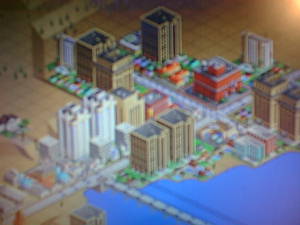Friday 14 September 2001

|
Pic of the day: The future of cities is hazy at best. (Picture made with SimCity 2000.) A farewell to towers?For more than 50 years, people have been flocking to the cities. At first, it was the population explosion and its surplus that was funnelled into the cities; but lately, the countryside has been sucked dry by the cities' ever growing hunger for human beings. Or is it the humans' ever growing hunger for cities? There have been at least three phases in this worldwide process of urbanization. A few hundred years ago, cities were centers of trade and administration; most people lived in the countryside. The most required skills overall were such as milking cows or mending fences, but some smiths and traders were also needed. With the industrial revolution, people were still treated much as generic work supply. But they were put together in large factories, because this was more efficient. The cities became both markets and labor pools at the same time, and growth became a self-sustaining process. For the last fifty years, people have specialized more and more. At the same time, more people than ever make their living by helping other people in some way: From flipping burgers to transplanting hearts. This means they have to work where the people are. In the cities. And the more specialized the work, the more likely that you can find work only in the biggest cities, so these grow the fastest. ***Despite urban sprawl (especially in America), the city centers have also grown. As the prices for a piece of ground there rose to incredible levels, it became cheaper to build upward than outward. The high rises rose higher and higher, becoming sky-scrapers that dwarfed even the Great Pyramid. And like the pyramids of old, they became a source of pride to the city and the people who worked there. The great cities all over the world competed to build the highest monuments to urban greatness. Until September 11, 2001. ***I see some Americans already propose that the twin towers will be rebuilt. And some add: "And twice as high!" This defiance is certainly possible, given the resources of the USA. But who would want to work there? And how productive would they be? I think I am not mistaken to say that today, not just in New York but in Hong Kong too, thousands of white-collar workers glanced out of the windows in their office towers, feeling horribly exposed. How long before the far-away roar of a jet plane will not cause rivers of cold sweat to run down their necks? If this event breaks the momentum, it is not by its own force alone. There has been a change in the tides. For a decade or so, the Internet has started to eat away at the concept of distance. Where men and (not least) women once had to visit huge file cabinets, today they can click the file cabinet icon on their computer screen. And, given the right password, they can bring up electronic documents that (10 years ago) used to be papers. They can do all this much faster than they used to with actual paper. While employers and employees both have reason to dislike working at home, it will still be far cheaper to have offices in small towns and suburbs where the ground itself is not as expensive as if it were paved with gold. There will still be both work and leisure that requires a rather large community in order to find the right match. Cities will almost certainly be a dominant feature for a long, long time to come. But it is likely that more people will seek something slightly less compact than Manhattan. And that many will prefer to work and live somewhere else than a world famous tower. |
Sunny day! |
Yesterday <-- This month --> Tomorrow?
One year ago
Two years ago